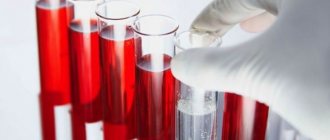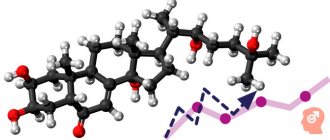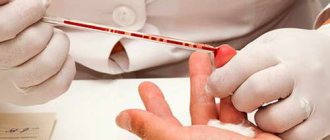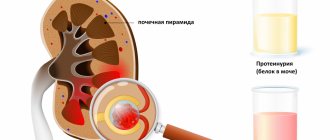An important role in the life of a modern woman is played by the state of her hormonal levels. The ability to reproduce, well-being, and beautiful appearance depend on it. Hormones are a factor that characterizes the quality of processes occurring in the female body.
A woman's hormone levels may vary depending on her age and the phase of the menstrual cycle. There are also certain differences in hormone levels in women after menopause.
Too high or low amounts of hormones may indicate the presence of diseases or problems with metabolic processes. If the body fails to produce hormones, this can cause infertility.
Background research allows you to determine the level of hormones and detect problems in the functioning of organs and systems. Timely diagnosis makes it possible to establish the cause of diseases and prevent their development. Only a qualified doctor can accurately assess test results and prescribe effective treatment.
General definition
A blood test for hormones can reveal whether hormonal balance is disturbed. Today there is an increase in endocrine diseases caused by dysfunction of the endocrine glands. To prevent negative consequences by starting therapy in a timely manner, it is recommended to regularly check your hormonal levels. This can be done in our multidisciplinary medical. Highly qualified specialists who have the best diagnostic equipment at their disposal will help identify problems in the body’s functioning at the earliest stages.
When is a hormonal test prescribed?
Hormones take part in almost all vital processes of the human body in one way or another. Starting from birth, they regulate a person’s health, his psycho-emotional state and life in general. Due to these biologically active substances, a person adapts to changes in the environment, enters into relationships, has children, in other words, exists normally. Hormonal imbalance can have the most serious consequences.
A blood test for hormones is not just prescribed. That is, during a routine examination, no one will do an examination of the endocrine system. Such diagnostics, as a rule, are carried out exclusively on the direction of a doctor who suspects disorders of the thyroid gland, diabetes mellitus or other endocrine disease. In addition, such an analysis is often prescribed for girls and women suffering from constant irregularities in the menstrual cycle, infertility, acne, recurrent miscarriages and obesity.
For pregnant women, this is one of the mandatory studies, since a lack of one or another hormone can lead to irreversible consequences.
When thyroid-stimulating hormone is below normal
It is reduced as a result of an increase in the amount of other hormones of the endocrine system. They are independently synthesized in the thyroid gland during the development of diseases. Indicators up to 0.01 units are considered low. This means that it is necessary to treat the pathologies that caused the low TSH concentration. Among them are:
- damage to the pituitary gland or insufficient blood flow to it;
- stress factor;
- improper use of hormonal drugs;
- prolonged fasting or a diet poor in vitamins.
Such deviations are accompanied by constipation, fever, loss of strength, and irritability. Your hands may become numb or tremble. At the same time, you quickly gain weight and your appetite increases.
In order to get rid of illness and improve your health, you first need to undergo an examination. After diagnosis, the doctor prescribes treatment. The drug course is designed to reduce the concentration of hormones T3 and T4. Due to this, the functioning of the endocrine system is normalized. Treatment methods depend on the nature of the pathology:
- If nodular goiter is detected, radiotherapy is necessary. In particularly advanced cases, surgical intervention is required.
- When the reason is the incorrect use of hormonal drugs, their dose is adjusted or their use is temporarily stopped.
- Symptomatic therapy is mandatory - warming up the patient, following a diet (not to be confused with fasting).
The TSH norm in women over the age of 50-55 remains constant. Based on the results of tests for the concentration of thyroid hormones, the general state of health is assessed. If there are deviations from normal values, the endocrinologist prescribes treatment to stabilize metabolic processes in the body.
How to take it correctly
Blood for analysis is taken from a vein. Depending on the symptoms, the doctor identifies a group of hormones that need to be tested. It is advisable to completely limit physical and psycho-emotional stress for 12 hours, not to drink alcohol, medications or food containing iodine.
Particular attention is required in preparation for donating blood samples for representatives of the fair half - it should be carried out during a certain period of the menstrual cycle, which is designated by the doctor. The donation procedure itself, as a rule, is scheduled for the morning hours, on an empty stomach.
The influence of hormones on processes in a woman’s body
Many important processes and functions of the female body depend on the level of hormones. For example, the ability to reproduce depends on gonadotropic hormones (FSH, LH, prolactin).
An excess or, conversely, a deficiency of thyroid-stimulating hormone can have a negative effect. And female sex hormones, which are produced by the ovaries, interacting with pituitary hormones, are responsible for the regularity of the menstrual cycle.
The development of the endometrium during the menstrual cycle depends on the level of the hormone estradiol; the maturation of the endometrium is influenced by the hormone progesterone.
General indicators, decoding
A complete picture of the state of the body and hormonal levels can be obtained by passing one of the following types of tests:
Thyroid hormones:
- Free T4 is one of the most important biologically active substances of the thyroid gland, which is responsible for transporting protein compounds and maintaining their optimal balance in the body. The normal plasma level for a healthy person is from 10 to 22 mmol/l. An excess indicates somatic or mental illnesses, lipemia. Deficiency - about pregnancy, poor nutrition, heavy physical activity, use of a number of medications.
- TSH – directly affects the thyroid gland and is responsible for the circulation of its components. The norm for an absolutely healthy person is from 0.4 to 4 mU/liter. An excess indicates adrenal insufficiency, complex non-thyroid pathology, etc. Low level – about thyrotoxicosis, cortisol imbalance, etc.
- T3 general - needed to stabilize the peripheral endocrine glands. The norm is 1.3 – 2.7 nmol/l. An excess of the hormone indicates pregnancy, taking drugs or estrogen. Disadvantage - about gastrointestinal pathology, acromegaly, hemolysis, starvation and other disorders.
- Total T4 is one of the main bioactive substances of the thyroid gland. Correct values are from 59 to 160 nmol/l. Going beyond these numbers to a greater extent can indicate obesity, the presence of hepatitis, pregnancy, etc., to a lesser extent - about starvation, excessive physical activity, kidney and gastrointestinal diseases.
- Free T3 – stimulates oxygen circulation in soft tissues. The normal range is from 2.6 to 5.6 pmol per liter. Exceeding the indicators indicates hyperthyroidism, toxicosis, a deficiency indicates peripheral vascular resistance syndrome, taking iodine-containing medications.
- Antithyroglobulin antibodies (AT-TG) help identify some autoimmune diseases. The normal value ranges from 0 to 4.11 U/ml.
- TSH is one of the main functional elements of the thyroid gland. The norm for a healthy person ranges from 258 to 574 nmol/liter. A higher reading may indicate pregnancy, hepatitis or hypoproteinemia.
Sex hormones:
- Estradiol is an active component in the blood of women, which is responsible for the maturation of germ cells and affects the proper development of the fetus during pregnancy. The norm varies depending on the life cycle: from 200 to 286 pm/l (for women in the follicular phase), from 52 to 136 pm/l (for women during menopause) and from 441 to 576 (girls in the luteal phase). An excess indicates possible tumors on the ovaries, a deficiency indicates a failure in the release of gonadotropic hormones.
- Testosterone - directly affects the growth of muscle mass, strengthening bones, and the formation of sexual characteristics. Indicators range from 2 to 10 ng/ml in men and from 0.2 to 1 in women
- Progesterone appears in the body after the formation of the egg. The pregnancy hormone, as it is also called, is responsible for the stability of the development of the intrauterine fetus. The norm is from 22 to 30 nm/l in the luteal phase, 1 – 2.3 nm/l in the follicular phase, 1 – 1.8 during menopause. If the value is higher than normal, then this may indicate pathological processes in the adrenal cortex, if less, it may indicate ovarian sclerosis.
Pituitary hormones:
- ACTH is responsible for the release of bioactive substances in the adrenal cortex. Correct values are up to 50 pg/ml. If more, hyperplasia is possible, less - adrenal insufficiency, tumor.
- Prolactin is responsible for stimulating lactation in women and the functioning of the prostate in representatives of the stronger half. For the latter, the norm is from 100 to 266 µg/l, for women of childbearing age from 129 to 539 µg/l, for women in menopause – from 106 to 289 µg/l.
- Growth hormone is responsible for the development of bone and muscle mass and other important organs. The norm is up to 10 ng/ml. Elevated levels indicate acromegaly or gigantism, while low values indicate pituitary dwarfism.
- LH – ensures the complete maturation of the egg in women and sperm in men. The norm for guys is from 2.12 to 4 mIU/ml, for girls, depending on the menstrual cycle, from 1.55 to 53 mIU/ml. Deviation in one direction or another is a sign of various dysfunctions of the gonads.
Adrenal hormones:
- Adrenaline and norepinephrine are responsible for the rhythm of the heart muscle, pressure, blood vessels, motility, and form glucose levels. Correct values are from 1.9 to 2.45 nm/l and from 0.6 to 3.22, respectively. An excess indicates jaundice, renal pathologies, a deficiency indicates myasthenia gravis or damage to the hypothalamus.
- Cortisol – responsible for susceptibility to allergic reactions, systematizes the production of antibodies. The norm is from 229 to 749 nm/l. If the readings are lower, there is a possibility of Addison's disease or adrenal disease; exceeding the norm indicates an adenoma or cancer.
- Aldosterone is an important hormone responsible for the balance of water and salt. The correct value ranges from 30 to 172 pg/ml. Deficiency is a sign of thrombosis, poor nutrition, arterial embolism. An excess may indicate a tumor in the adrenal glands or hyperplasia.
Hormonal influence on the menstrual cycle
Depending on the content of LH, FSH, and estrogens in the blood, the menstrual cycle in women is divided into three phases, one replacing the other:
- Follicular (menstrual) - average duration 2 weeks (7-22 days), the end of the ovarian cycle. It begins on the first day of menstruation, when the functional layer of the endometrium is shed, coming out with menstrual blood and glandular secretions. During this phase, the dominant follicle matures, which has the largest number of FSH receptors and produces estradiol more than other follicles. The menstrual phase ends with a sharp release of LH from the pituitary gland, which gives rise to the next phase - the ovulatory phase.
- Ovulatory (proliferative) phase - average duration is approximately 3 days. The dominant follicle finally matures and becomes a Graafian vesicle, capable of admitting the egg. The ratio of FSH and LH changes. The phase is characterized by a wave-like release of LH, which stimulates active substances (prostaglandins and enzymes) that promote rupture of the walls of the Graafian vesicle and the release of the egg, that is, ovulation. This period is characterized by a decrease in estradiol and the development (not in all cases) of ovulatory syndrome. Many women feel ovulation by the appearance of pain in the lower abdomen and lower back. Ovulation occurs after the peak release of luteinizing hormone within 16-48 hours. Follicular fluid (5-10 ml) comes out with the egg.
- The luteal (secretory) phase - the average duration is 2 weeks, this is the most stable period of the cycle - the corpus luteum phase. After ovulation, the vesicle transforms into the corpus luteum, which secretes progesterone (called the pregnancy hormone), androgens (male steroids), and estradiol. Under the influence of these hormones, the endometrium thickens, secretes secretions, and prepares for the attachment of the oocyte.
At the end of the luteal phase, at the peak of the release of sex hormones, the production of FSH and LH decreases. If conception does not occur, the corpus luteum stops synthesizing estrogens and progesterone, after which it is destroyed. The negative feedback is interrupted, which contributes to the growth of LH and FSH and the beginning of a new cycle.









